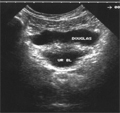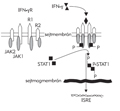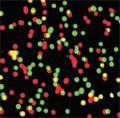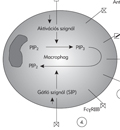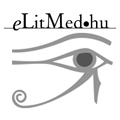The eLitMed.hu medical portal uses computer cookies for convenient operation. Detailed information can be found in the Cookie-policy.
Hungarian Immunology - 2002;1(01)
Content
[Patomechanism of hereditary angioneurotic oedema and provoking factors of oedematous attacks]
[The author describes the genetic background of hereditary angioneurotic edema, an autosomal dominant disorder. The pathomechanism of edemaformation and the significance of major mediator substances are explained along with clinical manifestations and their management. A special emphasis is placed on prophylaxis, the mainstay of which is the elimination of precipitating factors. The latter include mechanical trauma, diagnostic and therapeutic interventions performed in the cephalic-cervical region, mental stress, and sex hormones. The effect of endocrine therapies, ACE inhibitors, and infections - Helicobacter pylori in particular - on the natural course of the disease is also discussed.]
[Neonatal activation of interferon-γ in macrophages]
[Each individual passes through developmental or transient immunodeficiency due to the immaturity of the immune system in early childhood, expecially in the neonatal period. Therefore, neonates contract infections by intracellular and extracellular microorganisms more easily than older children and adults, and develop more severe disease with a high mortality rate. A number of abnormalities in the neonate’s host defense systems have been described suggesting that the immune system at birth functionally differs from that in adults. Neonatal T and B cells show decreased reactivity to antigens and mitogens and have deficienct IgM-IgG isotype switching. Newborns have decreased functional capacities of the hemolytic complement system. Under the same in vitro and in vivo conditions neonatal granulocytes show functional deficiency earlier than adult cells. Effector mechanisms of the cell-mediated immunity involve activation of macrophages by T helper1 cytokines, particularly interferon- γ (IFN-γ). IFN-γ is the most important macrophage-activating cytokine in vivo. Neonatal T cells express lower levels of IFN-γ and macrophages are hyporesponsive to activation by this cytokine. This deficiency may be explained by decreased phosphorilation of STAT1 despite comparable expression of STAT1 protein in neonatal and adult macrophages.]
[Relevances of anti-CD44 immunotherapy for cellular biology]
[INTRODUCTION - The CD44 molecule - the physiologic hialuronic acid receptor - is one of key mediators that direct the traffic of leukocytes into inflamed tissues. When applied in animal models of autoimmune arthritis, parenteral anti-CD44 antibody treatment exerts a dramatic antiinflammatory effect, but at high doses also a leukopenic effect. The goal of the present work is to elucidate the cellular basis of these phenomena. METHODS - In this study the authors used Western blot, immunoprecipitation, cell adhesion studies, flow chamber system studies (leukocyte rolling) and fluorescence microscopy following fluorescent labeling of actin cytoskeleton. RESULTS - Adhesion of CD44-expressing leukocytes to immobilized hialuronic acid does not result marked changes in cellular morphology. When incubated on immobilized anti-CD44 antibody, however, these cells spread, reorganize the actin cytoskeleton, and they adhere strongly to the surface. Studying the mechanisms of signal transduction, the authors found that engagement of CD44 with anti- CD44 antibody results in its enhanced association with numerous cytoskeletal regulator proteins, including ezrin, ankyrin, spectrin and focal adhesion kinase, thereby increasing the interaction between the cytoskeleton and the plasma membrane. Strong adhesion of the cells to immobilized anti-CD44 also prevents the rolling movement of these cells, mediated by CD44-hialuronic acid interactions, which precedes the extravasation of leukocytes to sites of inflammation. CONCLUSION - These results may provide insight into the antiinflammatory mechanisms of anti- CD44 antibody treatment. Based on these results and results published by other investigators, anti- CD44 antibodies may be uselful in the immunotherapy of rheumatic diseases.]
[Long-term follow-up of a large Hungarian lupus patient population]
[INTRODUCTION - The authors give a report about their experiences obtained by long-term follow-up of a large Hungarian lupus patient population. They also compare their results with literature data. PATIENTS AND METHODS - Clinical and laboratory characteristics of 800 SLE patients followed at this institution were analysed. Issues of diagnosis, therapy and outcome measures were also discussed. RESULTS AND DISCUSSION - Results indicate that the incidence and prevalence of SLE are increasing. Recently, milder cases are also recognised. Early diagnosis makes possible an early adequate therapy. Partly due to these the survival improved, and the mortality reduced. The compliance of patients also improved. The authors suggest the importance of regular medical follow-up. Despite of that, the clinical presentations of SLE have not been changed the disease became milder. Considering the longer survival in lupus, chronic complications, such as vascular diseases, osteoporosis and cancer are suspected to appear more frequently. On the other hand, there is a small group of patients still being in risk, as they fail to respond conventional immunosuppressive therapy. These patients die within a short period due to progression of SLE. This indicates the importance of research work on the pathogenesis of SLE. Based on the results of basic research novell immune modulator modalities should be developed.]
1.
Clinical Neuroscience
[Headache registry in Szeged: Experiences regarding to migraine patients]2.
Clinical Neuroscience
[The new target population of stroke awareness campaign: Kindergarten students ]3.
Clinical Neuroscience
Is there any difference in mortality rates of atrial fibrillation detected before or after ischemic stroke?4.
Clinical Neuroscience
Factors influencing the level of stigma in Parkinson’s disease in western Turkey5.
Clinical Neuroscience
[The effects of demographic and clinical factors on the severity of poststroke aphasia]1.
2.
Clinical Oncology
[Pancreatic cancer: ESMO Clinical Practice Guideline for diagnosis, treatment and follow-up]3.
Clinical Oncology
[Pharmacovigilance landscape – Lessons from the past and opportunities for future]4.
5.
